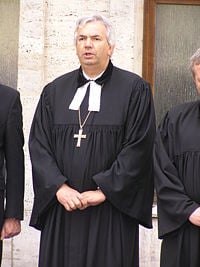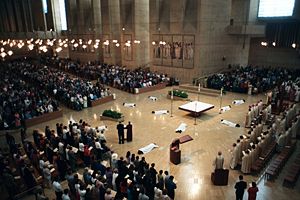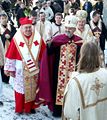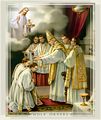Holy Orders
| Part of a series of articles on Christianity | ||||||

| ||||||
|
Foundations Bible Christian theology History and traditions
Topics in Christianity Important figures | ||||||
The term Holy Orders comes from the Latin Ordo (order) and the word holy referring to the church. Historically, an order refers to an established civil body or organization with a hierarchy. Thus, the term holy order has come into usage referring to a group with a hierarchy that is engaged in the ministry and leadership of religious group. Within the Christian Church, the term takes on an even more specific meaning when it is used to refer to a holy order as one of the Holy Sacraments/Mysteries instituted by Jesus Christ as a tenet of faith of the Roman Catholic Church, the Eastern Orthodox Church and the Anglican Church.
Members of holy orders, as leaders of their religious communities, hold the power to make their respective communities thrive or founder. They are responsible to lead the members of their communities of faith in the right direction, toward a moral and holy life, toward mutual support in their community, and toward spiritual health. Sometimes, in their zeal to further their own community of faith, members of holy orders may influence those following them to pursue the vitality and success of their own community of faith even at the expense of others, giving rise to conflicts between religious communities, an unfortunate contribution to the modern world in its struggle to achieve universal peace.

Origin



Early in his ministry, Jesus Christ called several individuals, most of them fishermen, to follow him and be his disciples, and they came to be known as the twelve apostles. These were his assistants and close aides.
He appointed twelve, that they might be with him and that he might send them out to preach and to have authority to drive out demons (Mark 3:14-15, TNIV).
They were even given the authority to perform miracles, such as casting out demons as Jesus did. Before leaving this world, Jesus sent them to spread his gospel throughout the world, to find new disciples (John 20:21) and to be his representatives on earth.
As the apostles started their mission, the need to get help and assistance and even to nurture successors arose. They needed to ordain new converts to join them in leading the church. The ordination ritual was characterized by the laying of hands on the appointee (Acts 6:1-7). This ritual of ordination for those called to Holy Orders is now one of the Holy Sacraments in the Roman Catholic Church. In the Eastern Orthodox Church, the ceremony is considered one of the Holy Mysteries.
According to the theory of apostolic succession, the ritual of successors and assistants being appointed by those who preceded them in the ministry is the key element of the legitimacy of the holy order of each church. As a member of a holy order, one must be ordained by someone who was himself ordained. The chain of ordination links each member of the order back in a direct line of succession to one of the apostles. Thus, there exist a historical and spiritual connection between each member of a holy order, the apostles, and the Christ.
The effect of being ordained
Being ordained in a holy order allows one to partake in special grace as God’s minister and to receive spiritual power. That power conferred at ordination is permanent and cannot be revoked, in contrast to the power given to office holders such as archbishops or deans that is revoked immediately when the person leaves office.
In all denominations and religions, holy orders are considered more of a vocation than occupation as they involve complete commitment to their practice. The responsibilities and roles held by members of holy orders vary according to the faith, location, size, and history of the religious community to whom they serve.
These duties include leading worship services, offering intercession prayers, offering guidance to members of the religious community, instructing members of the community in rites, practices, and scriptures of their respective faiths. Those under holy orders minister to the poor, sick, elderly, and serve a host of other duties. In some communities, social or political leadership is provided by the same persons who provide religious leadership.
The hierarchy
Members of holy orders in the Catholic, Orthodox and Anglican churches are divided into three levels, the order of Bishop, the order of Priest and the order of Deacon. The bishop occupies the highest rank and is said to have the 'fullness of the order'. He is followed in the hierarchy by the priest, who may also be known as presbyter. The lowest in the hierarchy, bearing the mission of servant is the deacon. These three levels are described as the major orders in the Catholic and Orthodox Churches. The Orthodox Church recognizes another group of orders known as the minor orders. Minor orders are composed of the reader and the subdeacon.
The Priest
The word "Priest" is a translation of a derivation of the Latin sacerdos, meaning sacrifice. The priesthood is a sacrificial ministry and the priest is the official celebrant of the Eucharist, a rite following the commandment of Jesus at the Last Supper, ‚ÄúDo this in remembrance of me.‚ÄĚ
In ancient Israel, the culture from which the roots of the Christian church sprung, priests were the ones in charge of the altar and the temple, and the central priests were also allowed to offer sacrifices, and instruct the people about the laws of Moses. According to the teachings of the Apostle Paul, the Christians are the priests of the new Israel. This interpretation extends to the Roman Catholics who indicate that while all Christians are priests, the one who are ordained, in the position of successor to the apostles and as stewards of the Church, have a higher status of priesthood and thus receive special grace.
Starting from the third century, the term priest was applied to bishops who were the celebrants of the Eucharist. In the fourth century, the term was given to presbyters because of their newly granted authority to officiate the Eucharist. In the Catholic Church, priests hold only slightly less authority than bishops, and may confer all the sacraments except the sacrament of ordaining persons with holy orders. In the Orthodox Church, the priest serves at the direction of the Bishop who may confer to the priests the authority to minister in his diocese, or withdraw it, as he desires.
The Bishop
According to the tradition of apostolic succession, the order of bishop has its roots in apostolic times. Apostles appointed their successors as bishops through prayer and the laying of hands, giving them the apostolic authority and priority of rank. As the highest in rank, they can administer all of the sacraments/mysteries, and have the power to ordain priests and deacons. Under ordinary circumstances, the ordination of a bishop is usually officiated by three other bishops; only in some exceptional circumstances can a bishop be ordained by a single bishop.
A bishop is ordained for leadership, and has the spirit of governance. He is the chief priest, ruler and teacher of one or a number of churches, usually in a specific geographic area. In the Roman Catholic and the Anglican Church, this area is called diocese and the place the bishop officiates from is called a cathedral. In the Orthodox Church, a bishop governs over an autocephalous (independent) Church.
The Petrine doctrine, based on Matthew 16:18-19 and other Biblical references, is a doctrine of the Roman Catholic church, which holds that, since Peter was appointed by Christ as the head of the church, and then martyred in Rome, the seat of the worldwide church from that time on remained in Rome.
And I tell you that you are Peter, and on this rock I will build my church, and the gates of death will not overcome it (Matthew 16:18-19, TNIV).
On this basis, the Roman Catholics argue that the Bishop of Rome, as the official spiritual successor of Peter, is the head of the church. The Bishop of Rome has the title of Pope, the head of the Roman Catholic Church. However, in the Orthodox Church as well as the Anglican Church, all bishops are equals and patriarchs or synods of bishops exercise only an :oversight of care" among the body of coequal bishops.
It is also interesting to note that while bishops are appointed by the Pope in the Roman Catholic Church, in the Orthodox and Anglican Communions, they are elected. In the Anglican Church of England however, the bishops are appointed by the reigning monarch on the advice of the Prime Minister.
The Deacon
According to Christian tradition, the order of deacon started when the apostles ordained seven men to wait on them at table (Acts 6 1-7). Deacons serve as assistants to the bishop and the minister of service. In the early days, this meant taking care of the property of the diocese, a function that was terminated during the middle ages. In the Roman Catholic church, the liturgical function of the deacon consists in helping and serving the celebrant, who leads the mass and administers the Eucharist. Many protestant churches have deacons as lay officers with no sacramental or liturgical functions.
Who can be ordained
Any individual who feels a vocation to serve for the sake of God’s honor and the sanctification of service may be a candidate for ordination. Generally however, appointment to the holy orders is reserved for seminary graduates. In the Roman Catholic Church, a seminarian is often ordained as a deacon in his final year. Those who intend to continue and seek ordination as priests are referred as "transitional deacons." In the Orthodox Church, before entering the seminary, students are tonsured as readers, and may later be ordained as deacons or subdeacons. In the Anglican Church, ordination as deacons is given after graduation from theological college. It is important to note that as the elder and leader of the church, the Bishop has the last say in any ordination and often will make further inquiries about a candidate's life to ascertain his moral, intellectual and physical fitness before deciding whether to approve a candidate's application for ordination.
Holy orders and women
In some Christian traditions women may theoretically be ordained to the same orders as men. In others women are restricted from certain offices. The Church of England (in the Anglican Communion), for example, does not permit the consecration of women as bishops, though the Episcopal Church USA (the United States denomination that is part of the Anglican Communion) does. In some denominations women can be ordained as elders or deacons. Some denominations allow for the ordination of women for certain religious orders. Within certain traditions, such as the Anglican and Lutheran, there is a diversity of theology and practice regarding ordination of women. The Roman Catholic Church, in accordance with its understanding of the theological tradition on the issue, and the definitive clarification of the issue found in the encyclical letter Ordinatio Sacerdotalis (1994) written by Pope John Paul II, officially teaches that it has no authority to ordain women as priests and thus there is no possibility of female priests at any time in the future.
Holy orders and marriage
Historically the issue of marriage was a matter of personnel choice, as exemplified by the letters of Saint Paul. Celibacy is not a sacrament. It was not demanded of those with holy orders in the early church, and St. Peter was recorded as doing his mission along with his wife. However, in later times, the Roman Catholic church came to require celibacy for its priests and bishops. By contrast, in the Orthodox Church, marriage is allowed to deacons and priests, although Orthodox bishops are required to live in celibacy.
Ordination and orders in the Protestant church
There are many denominations of protestants, and likewise many variations in the process of calling and ordination to the ministry; however, there are some distinct differences between the state of being ordained in the protestant Christian church in contrast with the Catholic, Orthodox and Anglican churches. Perhaps the most important difference is that in the protestant denominations, the process of ordination affirms and lends authority to the calling to ministry, but without imparting a special spiritual state. One of the main points of the protestant reformation was that all believers have equal and direct access to God and to salvation, and that it was not necessary to approach the Lord through a mediator. The differences in ordination, and the accompanying differences in church hierarchy reflect this difference in beliefs.
Typically, protestant churches have three ranks of ordained leadership; pastors, who are required to be seminary graduates, and are ordained by the central authority of the denomination, and elders and deacons, who are ordained by the gathered congregation. Women and men are equally qualified for all positions, including pastor, in nearly all, if not all, protestant denominations. Protestant pastors, elders, and deacons are all permitted to marry.
Responsibilities
Members of holy orders are endowed with authority by the churches who ordain them. In addition, the legal systems in many modern societies also give special privileges to the clergy, in order to protect the sanctity of the church and the separation of church and state. This means that it is particularly for those who have taken holy orders to serve with sincerity, and be responsible to lead their congregations in the right direction, toward a good and holy life.
Unfortunately, there are times when members of holy orders do not live up to their responsibility, sometimes misusing funds that are entrusted to their care, sometimes sexually abusing those under their ministry, and sometimes leading those in their communities to oppose or work against other communities on the basis of different religious beliefs. Hopefully, the time will come when these problems can become a thing of the past.
A Gallery of Christian holy orders
See also
ReferencesISBN links support NWE through referral fees
- Campbell, Dennis M. The Yoke of Obedience: The Meaning of Ordination in Methodism. United Methodist studies. Nashville: Abingdon Press, 1988. ISBN 9780687466603
- Oden, Thomas C. Pastoral Theology: Essentials of Ministry. San Francisco: Harper & Row, 1983. ISBN 9780060663537.
- Willimon, William H. Calling & Character: Virtues of the Ordained Life. Nashville: Abingdon Press, 2000. ISBN 9780687090334.
- Willimon, William H. Pastor: The Theology and Practice of Ordained Ministry. Nashville, TN: Abingdon Press, 2002. ISBN 9780687045327.
Credits
New World Encyclopedia writers and editors rewrote and completed the Wikipedia article in accordance with New World Encyclopedia standards. This article abides by terms of the Creative Commons CC-by-sa 3.0 License (CC-by-sa), which may be used and disseminated with proper attribution. Credit is due under the terms of this license that can reference both the New World Encyclopedia contributors and the selfless volunteer contributors of the Wikimedia Foundation. To cite this article click here for a list of acceptable citing formats.The history of earlier contributions by wikipedians is accessible to researchers here:
The history of this article since it was imported to New World Encyclopedia:
Note: Some restrictions may apply to use of individual images which are separately licensed.

















